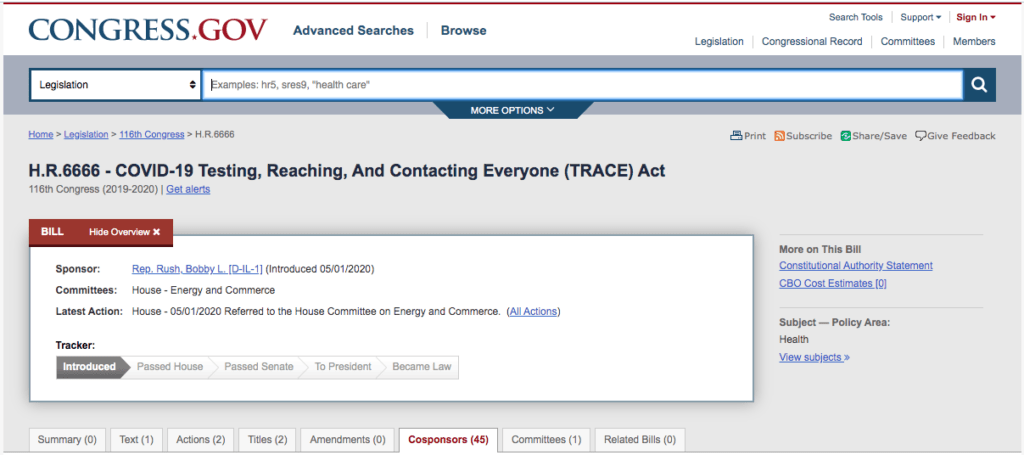COVID-19 Testing, Reaching, and Contacting Everyone (TRACE) Act

| Rep. Rush, Bobby L. [D-IL-1](Introduced 05/01/2020) |
|
116th CONGRESS
2d Session
|
To authorize the Secretary of Health and Human Services to award grants to eligible entities to conduct diagnostic testing for COVID–19, and related activities such as contact tracing, through mobile health units and, as necessary, at individuals’ residences, and for other purposes.
Mr. Rush (for himself, Ms. Barragán, Ms. Bass, Mr. Beyer, Mr. Brown of Maryland, Mr. Butterfield, Mr. Cárdenas, Mr. Carson of Indiana, Mr. Cohen, Mr. Correa, Mr. Cuellar, Ms. DeGette, Mrs. Demings, Mr. Gonzalez of Texas, Mr. Grijalva, Mr. Hastings, Mrs. Hayes, Mr. Higgins of New York, Ms. Kaptur, Mr. Khanna, Ms. Kuster of New Hampshire, Mr. Larson of Connecticut, Mr. Lynch, Ms. McCollum, Ms. Moore, Ms. Norton, Mr. Payne, Mr. Raskin, Mr. Rouda, Mr. Ryan, Mr. Sarbanes, Ms. Sewell of Alabama, Mr. Sires, Mr. Soto, Ms. Tlaib, Mr. Thompson of Mississippi, Mr. Van Drew, Ms. Velázquez, Ms. Wasserman Schultz, and Mrs. Napolitano) introduced the following bill; which was referred to the Committee on Energy and Commerce
To authorize the Secretary of Health and Human Services to award grants to eligible entities to conduct diagnostic testing for COVID–19, and related activities such as contact tracing, through mobile health units and, as necessary, at individuals’ residences, and for other purposes.
Be it enacted by the Senate and House of Representatives of the United States of America in Congress assembled,
SECTION 1. SHORT TITLE.
This Act may be cited as the “COVID–19 Testing, Reaching, And Contacting Everyone (TRACE) Act”.
SEC. 2. COVID–19 TESTING AND CONTACT TRACING USING MOBILE HEALTH UNITS.
(a) In General.—The Secretary of Health and Human Services, acting through the Director of the Centers for Disease Control and Prevention, may award grants to eligible entities to conduct diagnostic testing for COVID–19, to trace and monitor the contacts of infected individuals, and to support the quarantine of such contacts, through—
(1) mobile health units; and
(2) as necessary, testing individuals and providing individuals with services related to testing and quarantine at their residences.
(b) Permissible Uses Of Funds.—A grant recipient under this section may use the grant funds, in support of the activities described in subsection (a)—
(1) to hire, train, compensate, and pay the expenses of individuals; and
(2) to purchase personal protective equipment and other supplies.
(c) Priority.—In selecting grant recipients under this section, the Secretary shall give priority to—
(1) applicants proposing to conduct activities funded under this section in hot spots and medically underserved communities; and
(2) applicants that agree, in hiring individuals to carry out activities funded under this section, to hire residents of the area or community where the activities will primarily occur, with higher priority among applicants described in this paragraph given based on the percentage of individuals to be hired from such area or community.
(d) Distribution.—In selecting grant recipients under this section, the Secretary shall ensure that grants are distributed across urban and rural areas.
(e) Federal Privacy Requirements.—Nothing in this section shall be construed to supersede any Federal privacy or confidentiality requirement, including the regulations promulgated under section 264(c) of the Health Insurance Portability and Accountability Act of 1996 (Public Law 104–191; 110 Stat. 2033) and section 543 of the Public Health Service Act (42 U.S.C. 290dd–2).
(f) Definitions.—In this section:
(1) The term “eligible entity” means—
(A) a Federally qualified health center (as defined in section 1861(aa) of the Social Security Act (42 U.S.C. 1395x(aa)));
(B) a school-based health clinic;
(C) a disproportionate share hospital (as defined under the applicable State plan under title XIX of the Social Security Act (42 U.S.C. 1396 et seq.) pursuant to section 1923(a)(1)(A) of such Act (42 U.S.C. 1396r–4));
(D) an academic medical center;
(E) a nonprofit organization (including any such faith-based organization);
(F) an institution of higher education (as defined in section 101 of the Higher Education Act of 1965 (20 U.S.C. 1001));
(G) a high school (as defined in section 8101 of the Elementary and Secondary Education Act of 1965 (20 U.S.C. 7801)); or
(H) any other type of entity that is determined by the Secretary to be an eligible entity for purposes of this section.
(2) The term “emergency period” has the meaning given to that term in section 1135(g)(1)(B) of the Social Security Act (42 U.S.C. 1320b–5(g)(1)(B)).
(3) The term “hot spot” means a geographic area where the rate of infection with the virus that causes COVID–19 exceeds the national average.
(4) The term “medically underserved community” has the meaning given to that term in section 799B of the Public Health Service Act (42 U.S.C. 295p).
(5) The term “Secretary” means the Secretary of Health and Human Services.
(g) Authorization Of Appropriations.—To carry out this section, there are authorized to be appropriated—
(1) $100,000,000,000 for fiscal year 2020; and
(2) such sums as may be necessary for each of fiscal year 2021 and any subsequent fiscal year during which the emergency period continues.
Read the entire bill at:
https://www.congress.gov/bill/116th-congress/house-bill/6666/cosponsors?r=30&s=1&searchResultViewType=expanded&KWICView=false
